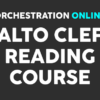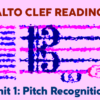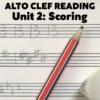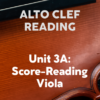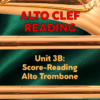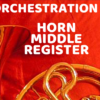Welcome to the Orchestration Online Alto Clef Reading Course, designed to quickly and permanently improve your ability to recognise any note on a C-clef, and to understand the context of its scoring for relevant instruments and voices.
Use this page as a home base while you take the course, accessing the different units from the list below. At the bottom, read the 2-Week Challenge guidelines, and see if it would be of any use in motivating you to a rapid and dedicated application of your abilities.
If some of these principles and study approaches appear daunting at your current level of training, don’t despair. Unit 1 should be attainable by most composers who can read treble and bass clefs, and Unit 2 will be workable from there. The information in Unit 3 is extensive, and may take longer than a 2-week dash, but is still presented from a ground-level start, and you can take it as far as you like.
For those who already have a fair deal of training, I recommend not skipping any steps, but starting from the beginning and covering all the materials carefully – as you may find that material you skipped over might contain a perspective or key detail upon which more advanced study may rely. All the same, this isn’t intended to be a university semester course, but simply a quick reinforcing of reading skills andrelevant instrumentation as a footnote to an ongoing life’s work of self-improvement through score-reading and creative accomplishments.
UNIT 1: ALTO CLEF PITCH RECOGNITION
System of alto clef pitch orientation • range of alto clef pitches • formulas for pitch recognition/memorisation
Drills: Focused flashcard training, by category, then adding together
Resources: Flashcard PDFs formatted to 4”x6”, A6, 4-up on US Legal, 4-up on A4
Historical alto clef approaches • the “13” and the “K” • key signature orientation • transcription from treble clef, bass clef, and grand staff.
Drill 1: Alto clef handwriting practice
Drill 2: Alto clef key signature handwriting practice
Drill 3: Transcribe treble clef excerpts to alto clef staff
Drill 4: Transcribe bass clef excerpts to alto clef staff
Drill 5: Transcribe grand staff excerpts to single alto clef staff
Resources: Staff paper US Letter, ditto A4, scoring keys for Drills 3-5
Score-reading ground rules (alto clef instruments, concert pitch always, viola changing clef, variation of characteristics, and extension of “standard models”) • viola range/registers • procedures for focused score study • preliminary overview of Bach Brandenburg Concerto no. 6
Score Study: Bach Brandenburg Concerto no. 6
Resources: Links to further viola solo works
UNIT 3B: SCORE-READING ALTO TROMBONE
Introduction to alto trombone and classical-era trombone family • historical context • score-reading guidelines • alto trombone range/registers • classical-era scoring basics
Score Study: Leopold Mozart Alto Trombone Concerto, others
Resources: PDF for preliminary study with L. Mozart concerto and further alto trombone solo works and featured scoring
UNIT 3C: SCORE-READING CONTRALTO VOICE
Alto range voices and tessitura • “contralto” ≠ “alto” • centring of C-clef types around different vocal ranges • eventual dominance of treble clef over alto vocal parts • contralto voice context, range, and registers • score-reading guidelines • J.S. Bach’s approach to contralto arias • Kathleen Ferrier’s voice and legacy
Score Study: J.S. Bach Contralto Voice Excerpts
Resources: Links to further study of contralto solo and alto choir parts in works by J.S. Bach, Beethoven, and W.A. Mozart; also to works featuring Ferrier as soloist by Glück, Mahler, and Britten
UNIT 4A: ALTO CLEF SIGHT-SINGING
Introduction to solfège or sight-singing • goals and procedures • overview of course materials
Drills: 100 Sight-singing Exercises
Resources: PDF file of above exercises
UNIT 4B: ALTO CLEF MELODIC DICTATION – COMING IN A FEW DAYS
2-WEEK CHALLENGE
This challenge can be undertaken at any time, and need not be started at the release of this course. The materials above may be studied in any way and within any available timeframe – but a 2-week goal can help motivate students to greater and more rapid achievement, as well as making a more impactful impression.
Suggested regimen
Days 1-3
- Flashcard practice, breaking down by category, then putting categories together. Develop very fast speed by working with partner to hold and turn cards. Take turns with each other.
- Scoring Drills 1 & 2 (by Days 2-3), handwriting alto clefs and alto clef key signatures.
- (Start sight-singing supplementary materials such as Slabbinck if not familiar with process.)
Days 4-5
- Scoring Drills 3-5, transcription of treble, bass, and grand staff examples to alto clef.
- Continue drilling flashcards.
Days 6-8
- Viola score study, playing through solo parts then listening while score-reading video.
- (Units 1-2 of Alto Clef Sight-Singing.)
Days 9-11
- Alto trombone score study, playing parts then listening with video as before.
- (Units 3-4 of Alto Clef Sight-Singing.)
- (Try out Melodic Dictation Exercises 1-20.)
Days 12-13
- Contralto score study, playing solo parts then listening as before.
- Review flashcard drills, see if you can get your speed to faster than your partner can turn the next card.
- (Unit 5 of Alto Clef Sight-Singing.)
- (Try out Melodic Dictation Exercises 21-50.)
Day 14 – Resources will be linked here by April 12


